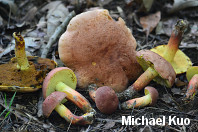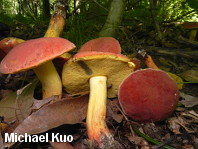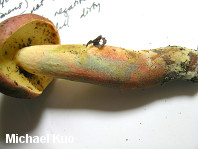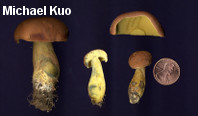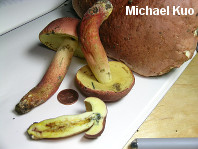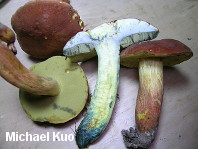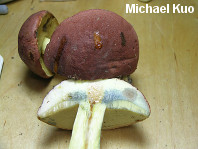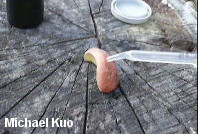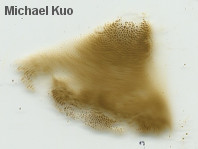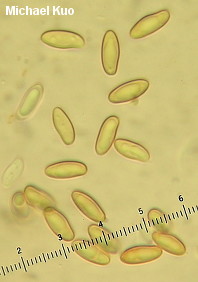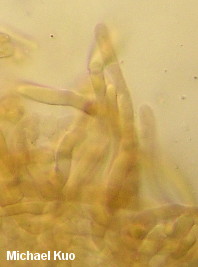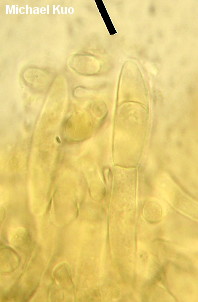| Major Groups > Boletes > "Boletus" | Red-Capped, Blue Staining > Boletus pseudosensibilis |

|
Boletus pseudosensibilis [ Basidiomycota > Boletales > Boletaceae > Boletus . . . ] by Michael Kuo This frequently misidentified eastern North American bolete is associated primarily with oaks, in upland hardwood forests. It features a red to reddish brown cap, a blue staining pore surface, and a distinctive stem that is mostly yellow, flushed with red over the bottom portion. When fresh the stem bruises moderately bluish where handled, and this helps separate it from two look-alikes, Boletus sensibilis, with a stem that bruises very blue, and Boletus bicolor, with a stem that does not bruise or, rarely, bruises very faintly. Additionally, Boletus pseudosensibilis has a cap that flashes blue to green with a drop of ammonia, along with distinctive pileipellis elements (see below). See the key to red-capped, blue-staining boletes and the printable comparison table for three often-confused boletes for further discussion and help with identification. My assessment of the pileipellis of this species disagrees in part with that of Smith & Thiers (1971), who describe it as a "cutis" that is "never a trichoderm"; in my collections the youngest caps manifest a trichoderm, which soon collapses and then appears like a cutis. Additionally, the young terminal elements in my collections are not swollen and short-septate; this feature only develops with maturity. Description: Ecology: Mycorrhizal with oaks, and possibly with other hardwoods; growing scattered, or gregariously; summer and fall; widely distributed in eastern North America. The illustrated and described collections are from Illinois. Cap: 4-16 cm; convex, becoming broadly convex; dry; finely velvety when young but soon bald; red to reddish brown or pinkish brown (most commonly reddish brown), fading to pinkish tan; when young sometimes bruising grayish where rubbed; the margin at first tucked under. Pore Surface: Bright yellow when young, maturing to dirty orangish olive; when very young not bruising, or bruising only faintly, but soon bruising promptly blue, then slowly brown; with 1-2 circular to angular pores per mm at maturity; tubes shallow, 4-8 mm deep (rarely to 10 mm deep, in very large caps). Stem: 6-10 cm long; 1-2.5 cm thick; usually tapered at the base; dry; solid; bald; yellow overall, with reddish tinges developing in the bottom half; bruising light blue where handled (then, over time, slowly brownish); not reticulate; basal mycelium pale to dark yellow, or sometimes whitish. Flesh: Yellow in the cap; deep yellow or sometimes reddish in the stem; staining blue on exposure--sometimes faintly and erratically (staining usually more pronounced on older specimens). Odor and Taste: Not distinctive. Chemical Reactions: Ammonia flashing purplish blue to blue-green, then resolving to negative, grayish, or orangish on cap surface; negative on flesh. KOH reddish to dull orange or negative on cap surface; orangish on flesh. Iron salts grayish on cap; grayish or negative on flesh. Spore Print: Dull olive brown. Microscopic Features: Spores 9-12.5 x 3.5-4.5 µ; subfusoid; smooth; orangish brown to golden in KOH; brownish in Melzer's. Hymenial cystidia fusoid-ventricose; 20-35 x 5-10 µ; hyaline or with orangish contents in KOH. Pileipellis a collapsing trichoderm of elements 5-12.5 (-15) µ wide, smooth, hyaline to ochraceous or golden in KOH; at first with primarily tubular terminal cells, but by maturity developing many subterminal and terminal cells that are septate at short intervals, with terminal cell tubular or obnapiform. REFERENCES: Smith & Thiers, 1971. (Smith, Smith & Weber, 1981; Phillips, 1991/2005; Both, 1993; Bessette, Roody & Bessette, 2000; Roody, 2003; Kuo & Methven, 2014.) Herb. Kuo 07250304, 08210501, 07300701, 07231001, 09031401. This site contains no information about the edibility or toxicity of mushrooms. |
© MushroomExpert.Com |
|
Cite this page as: Kuo, M. (2015, January). Boletus pseudosensibilis. Retrieved from the MushroomExpert.Com Web site: http://www.mushroomexpert.com/boletus_pseudosensibilis.html |
